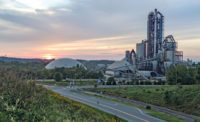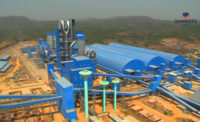Nigeria Cement Makers Grapple With New Regulations

Nigeria cement manufacturers and other stakeholders have expressed mixed reactions to a move by the country's standards regulatory agency to dictate cement production and use.
The Standards Organisation of Nigeria (SON) has directed all cement makers to ensure that, before their product is released to the market, packaging material contains detailed information on the quality of the cement and what it is used for. The agency also has given guidelines on which type of cement should be used for what construction works, triggering protests from the country's two leading cement manufacturers, Lafarge WAPCO and Dangote Cement.
SON says cement-packaging material should be labeled CEM1 52.5R, 52.5N, CEM II 42.5R, 42.5N or CEM I&II 32.5R, 32.5N, which are globally accepted cement grades for construction works. The regulator says 52.5-grade cement will be used in construction of bridges, flyovers and high-rise buildings. Grade 42.5 cement will be for casting columns, beams, slabs, blocks and molding, while 32.5-grade cement will be for only plastering.
The regulation aims to tackle sale of substandard construction material in the market and end the frequent collapse of buildings and infrastructure built with Nigerian-made cement, according to SON. However, Lafarge, which produces large volumes of 32.5-grade cement at its three manufacturing plants (Ewekoro I & II and Sagamu), has raised concerns over SON's claim that this type of cement is linked to collapsing buildings.
"Professionals in the built sector in Nigeria ... have stated clearly that there is no substandard cement in Nigeria; cement quality is not responsible for building collapse in Nigeria; 32.5-grade cement is not inferior to any other grade, and it could be used for several construction activities," wrote Viola Graham-Douglas, Lafarge corporate communications director, in a June 13 email. "We stand by this empirical and technical position and believe that the problem of building collapse is not caused by poor product quality but by poor product application."
Officials at Lafarge, which has initiated legal action against SON, hope "good sense will prevail and the purported cement classification will not be enforced," Graham-Douglas said. "This is because it will adversely impact production cost, not only for Lafarge but also for other players. However, the real impact will be the need to change the concrete codes, its impact on ongoing contracts, [and] the confusion and disruption it will bring to the industry, especially knowing that the issue with building collapse is not cement."
Earlier, Lafarge, which is the only Nigerian producer of branded cement, such as Elephant, Supaset and Powermax, had challenged SON and other regulatory agencies to look into alleged issues of faulty designs, poor practices, non-involvement of professionals in building projects, overloading due to changes in initial building plans, among others, for economic gains, saying they "are contributory factors to the building collapse." The company suggested Nigeria's underdeveloped steel industry, "poor level of electricity generation and supply, [and] lack of efficient and properly equipped laboratories for testing materials has hampered the certification and growth process."
Analysts have predicted a likely decline in the profits of Lafarge's Nigeria operations if it shifts to producting more 42.5-grade cement than 32.5-grade cement.
"Lafarge produces more of the 32.5-grade cement and will need to incur additional costs for the higher grades, resulting in lower margins," Pabina Yinkere of the Lagos-based Vetiva Capital Management Ltd. told Bloomberg in early June.
However, Nigeria's market leader, Dangote Cement Plc, has supported SON on the new regulations on cement use, saying compliance will enhance the quality of built infrastructure and the safety of construction workers.
"We call on SON to immediately go ahead and implement the new standards. Yes, it may be a bit expensive, but it doesn't take time to switch over to 42.5-grade cement," said Etim Ekanem, Dangote Cement director, in May.
Globally, construction markets already are phasing out 32.5-grade cement.
"World cement leader China is phasing out 32.5-grade cement by July. India, the second-largest producer, phased out 32.5-grade cement 12 years ago," Ekanem noted.




